There’s nothing new to report
; Arsenalare the best team in set-pieces in the Premier League, scoring eight goals from set-pieces from 9.01 xG, with the Gunners being the league’s best-ranked side in both categories.
Seven of 34 goals for the Nicolas Jover-coached team come from corner kicks, representing nearly 21% of the total, so teams try to find a way to stop this continuous danger.
One of these tactics to stop Arsenal was using counterattack players while defending their corners, forcing them to drop three attackers back.
In their most recent match, Gabriel Jesus scored Arsenal’s second goal against Crystal Palace from the second ball of a corner kick. This gives us a chance to discuss the advantages and disadvantages of this trick, especially since Arsenal managed to threaten the goal and hit the crossbar from another corner kick.In this tactical analysis, we will discuss this trick by showing examples from Arsenal and Parma.
We will analyse:
1- Is it really useful to defend the box?
2- The second ball problem
4- Some probable advantages you can see (at a specific level)
Is It Useful To Defend The Box?
First of all, we should analyse whether this trick stopped Arsenal’s threat or not, so we will discuss all the teams that implemented this idea (AS Monaco, Paris Saint-Germain and Crystal Palace)
The main idea is to force Arsenal to drop three players, with these three counterattack players trying to reduce the number of Mikel Arteta‘s attackers.
pic.twitter.com/maFTEkLjVb
— Footie Clips (@FootieClips) December 24, 2024
As shown below, Crystal Palace, in the EFL Cup, defend zonally with five players inside the six-yard box, one player in the second line and a player to defend the second ball while the other three players stand forward.
Arsenal naturally ask three players to stand with these three, with a player on the edge of the box and five players in the box.
Arsenal simply implement their usual idea in a small way to target Mikel Merino (white).
At the same time, the other four have the mission to block the last three zonal defenders and the goalkeeper.
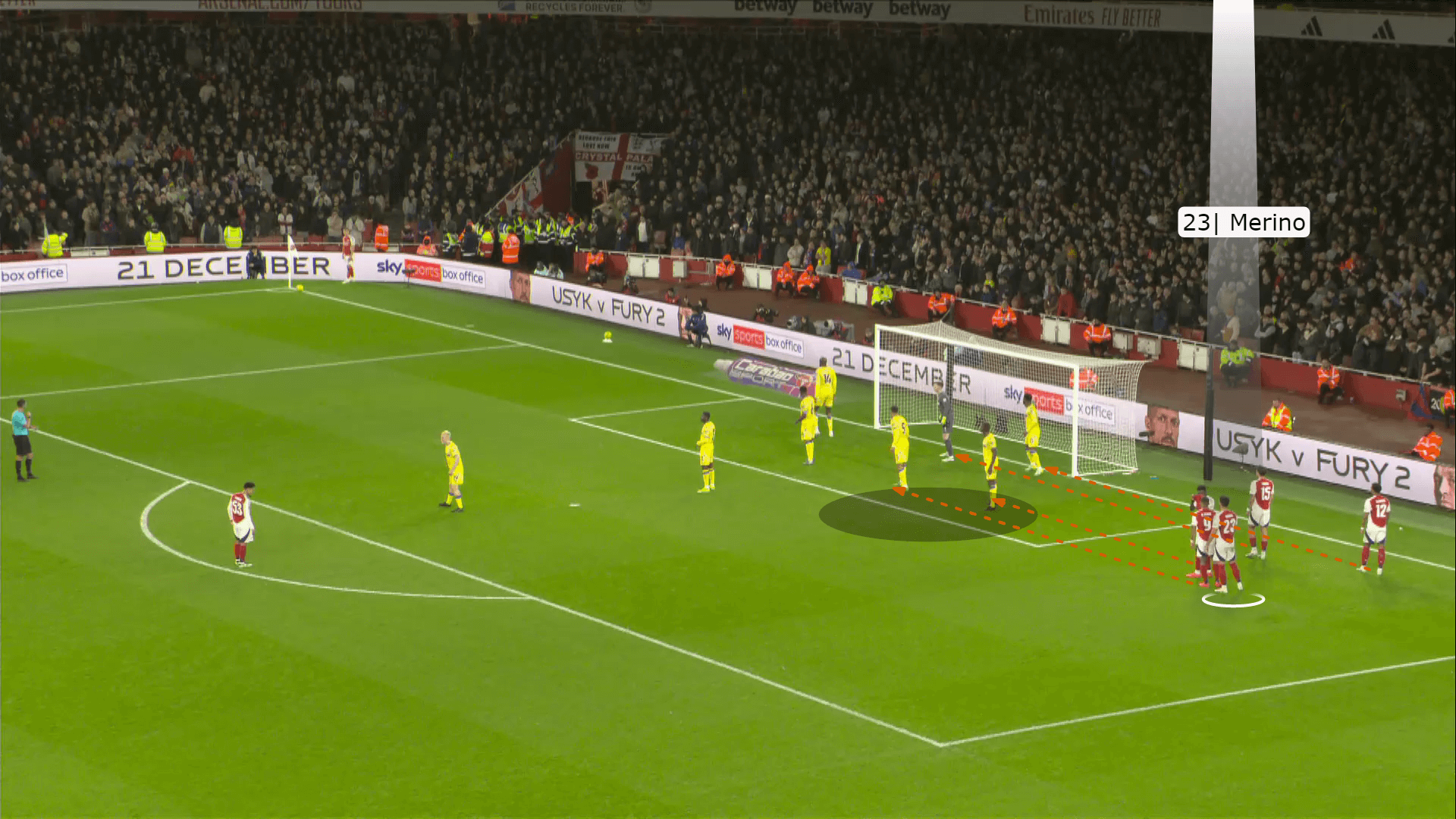
The plan works, as shown in the photo below, but this trick doesn’t help in this case.
The cross isn’t optimal, so Merino must step back to nod the ball for the other four players, as in the following photos.
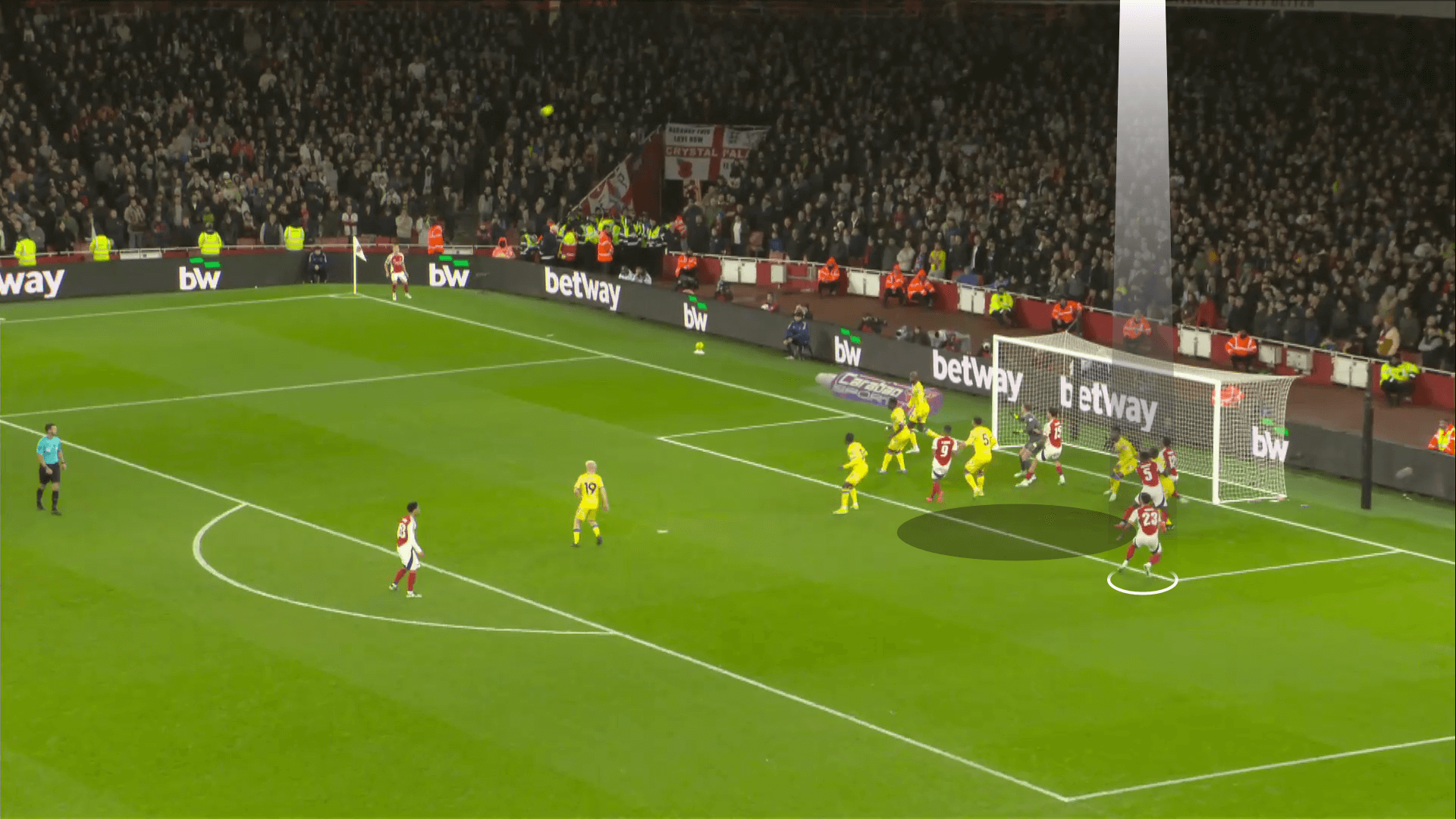
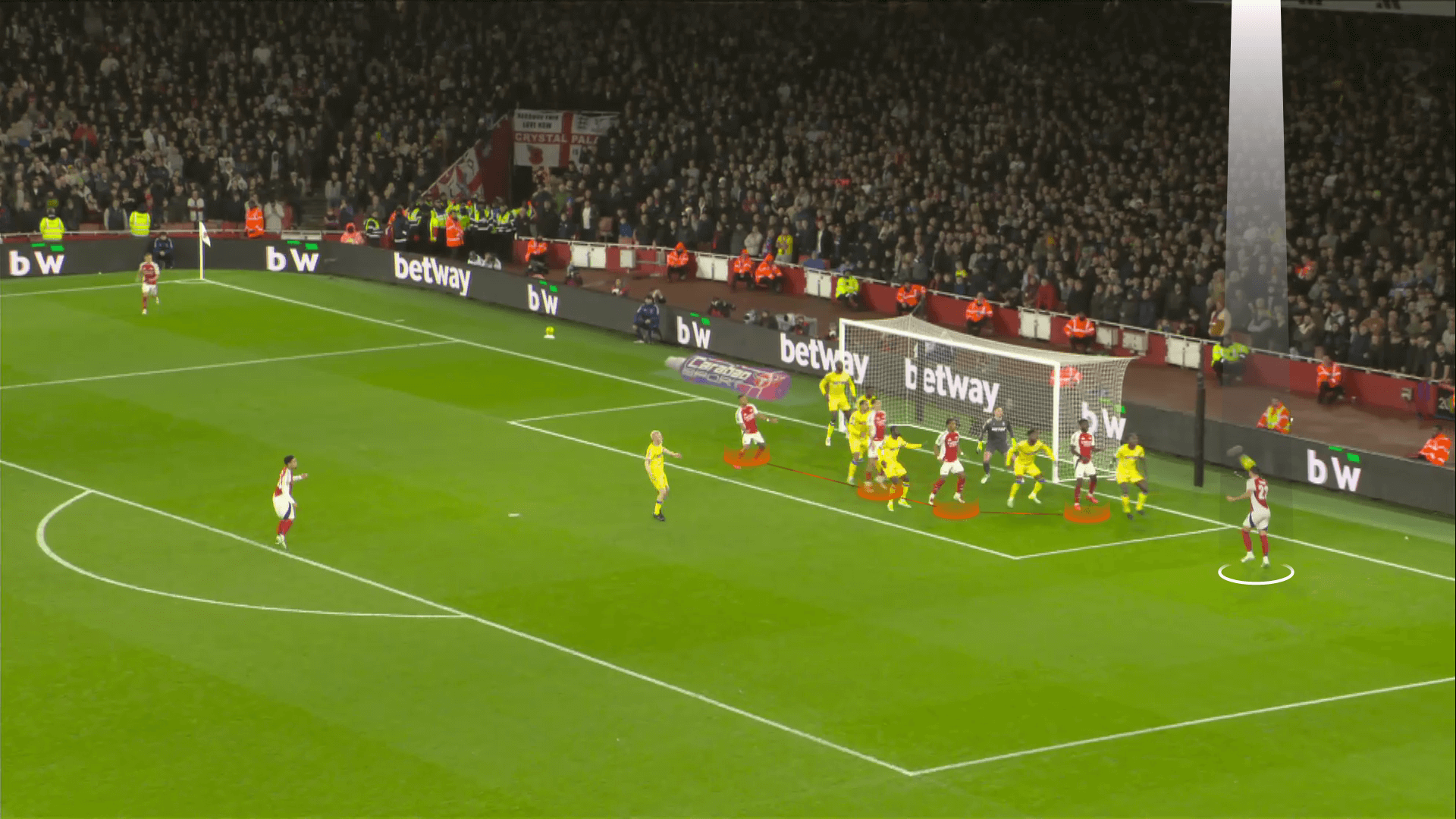
After that, they met each other again in the Premier League last Saturday.
pic.twitter.com/4kSl1dDkLa
— Footie Clips (@FootieClips) December 24, 2024
Here, we see almost the same strategy, except Gabriel Magalhães starts in his usual position.
In this case, the zonal defender on the second line becomes a man marker for him.
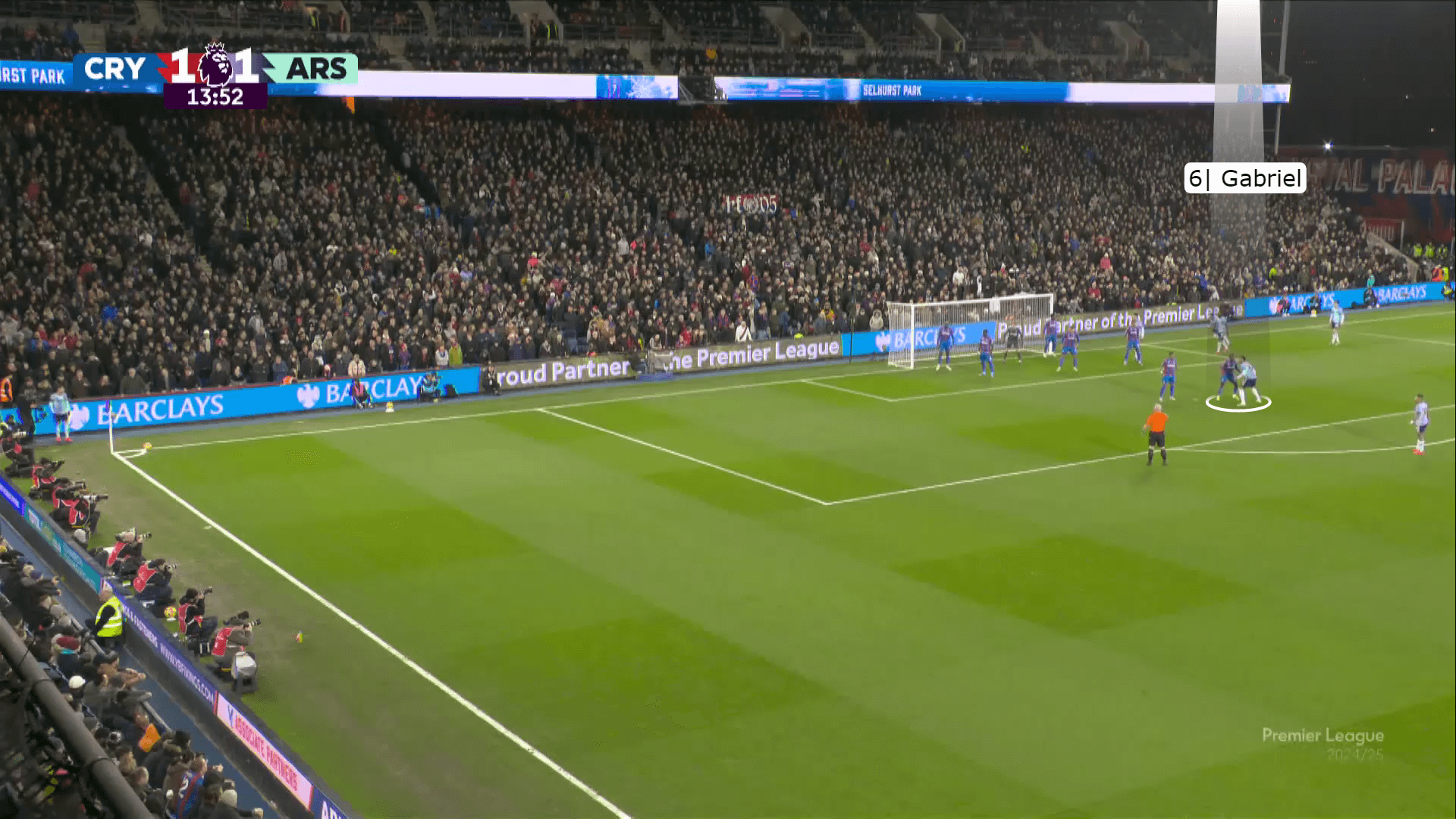
Gabriel makes his usual feint, faking a move to the near post (toward the ball) before taking off to the far post.
This causes his marker to have an orientation problem, which means that he can’t track Gabriel and the ball at the same time.
Kai Havertz also implements his usual role of doing the targeted area from another starting direction to be ready in case the cross passes Gabriel while three players (orange) block the last two zonal defenders and the goalkeeper.
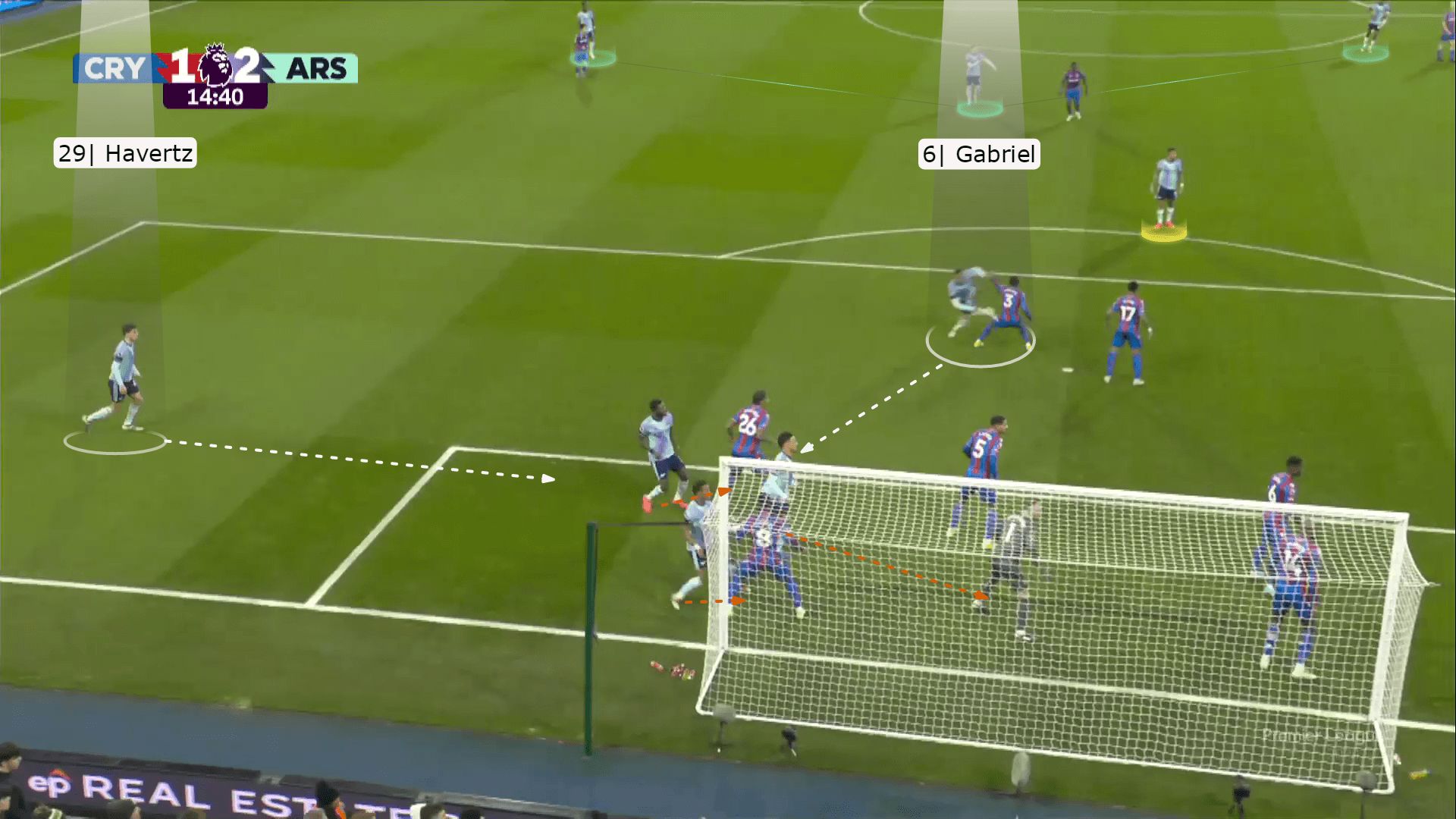
As shown below, the plan works excellently.
However, the cross was a bit floated, taking time in the air, so the zonal defender escaped from Jurrien Timber.
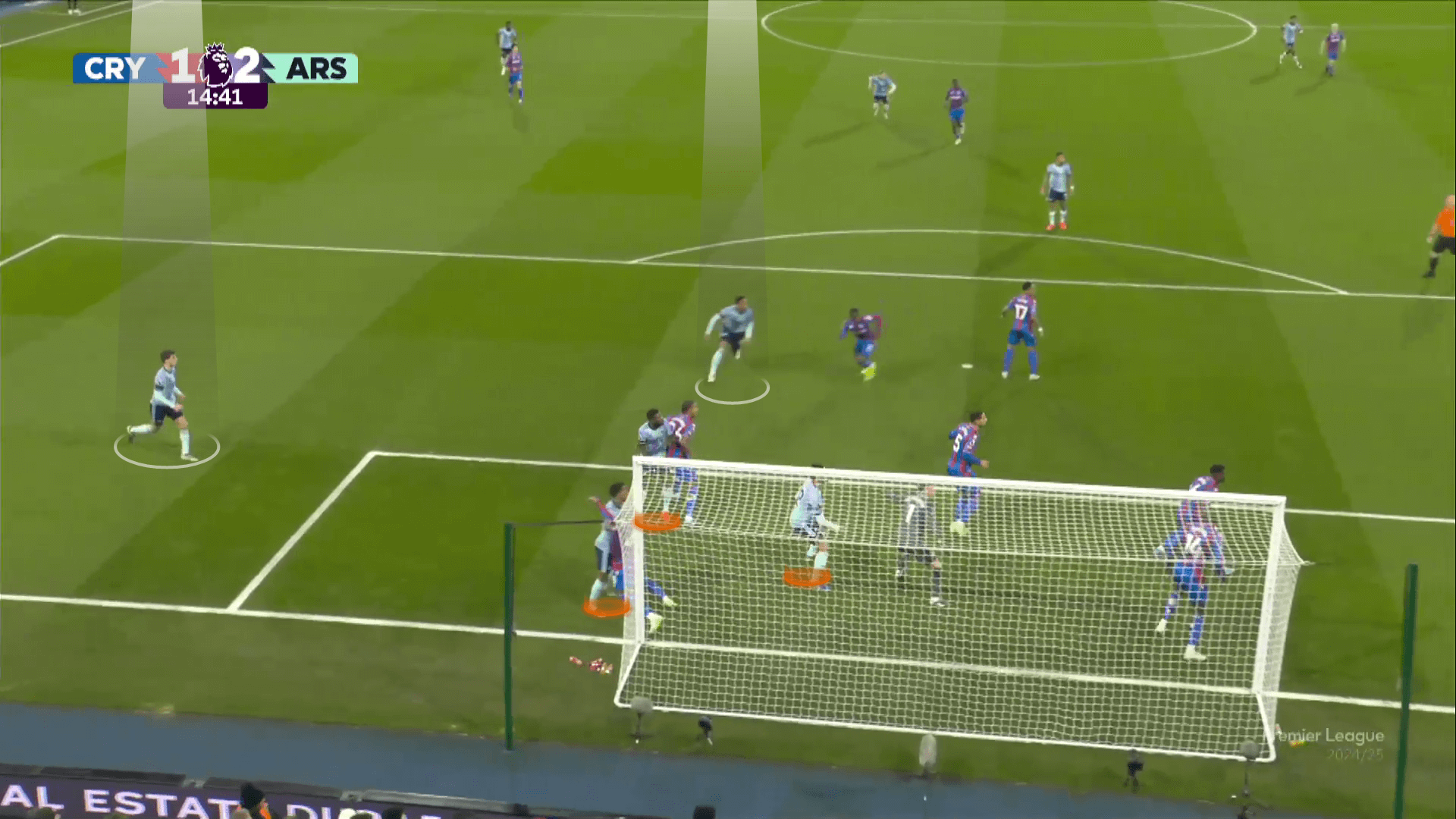
Before that, AS Monaco also implemented a similar strategy.
In the photo below, they defend the box with only a zonal defender (blue) and four man markers knowing that there is a short-option defender with Arsenal’s one (out of the shot), a defender on the edge of the box and the three forward players.
This situation inside the box is so dangerous because it concerns not only the number but also the large area of conflict, which means that any mistake or trick leads to a goal.
If an attacker can overcome his man marker, it will be fatal, especially in this large space, which is enough to run, feint and escape from man markers.
Escaping from a man-marking defending system is no longer a big issue for elite teams because they can easily use dismarking techniques, like blocks (screens), orientation problems and mismatch, which is shown in this analysis.
However, this isn’t the biggest problem, so we will move to the second issue, which is the difficulty of getting the second ball.
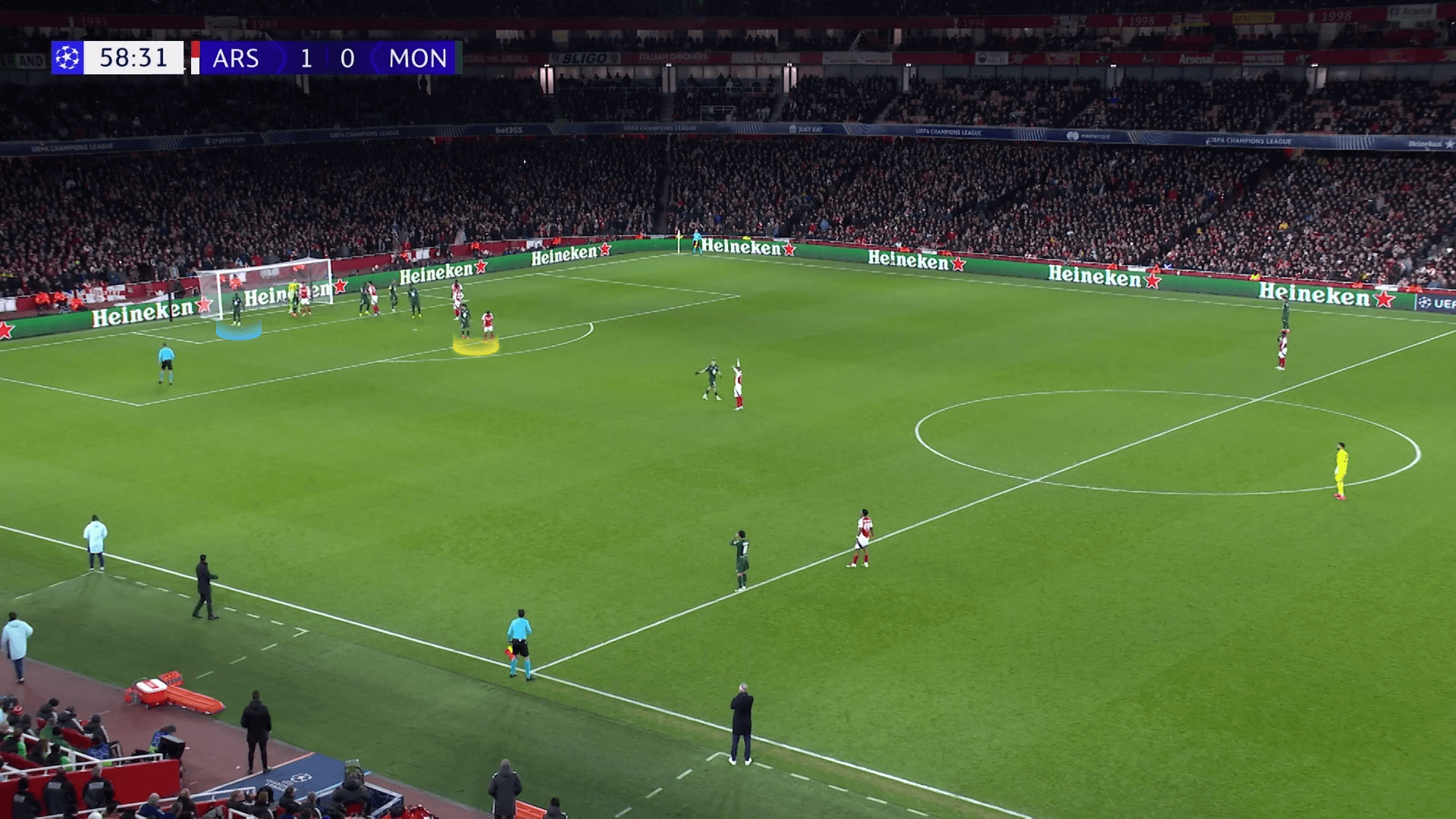
Second Ball Problem
As shown below, all of the defenders are inside the six-yard box, with only the rebound player (yellow) on the edge of the box.
This means that the large space between the six-yard box and the edge of the penalty box is empty.
pic.twitter.com/F9kSIrJ6IV
— Footie Clips (@FootieClips) December 24, 2024
The small number of defenders inside the box makes it difficult for the defending team to get the second ball.
As you can see below, Partey cuts all that way to get the second ball after the goalkeeper’s clearance to sustain pressure on Monaco.
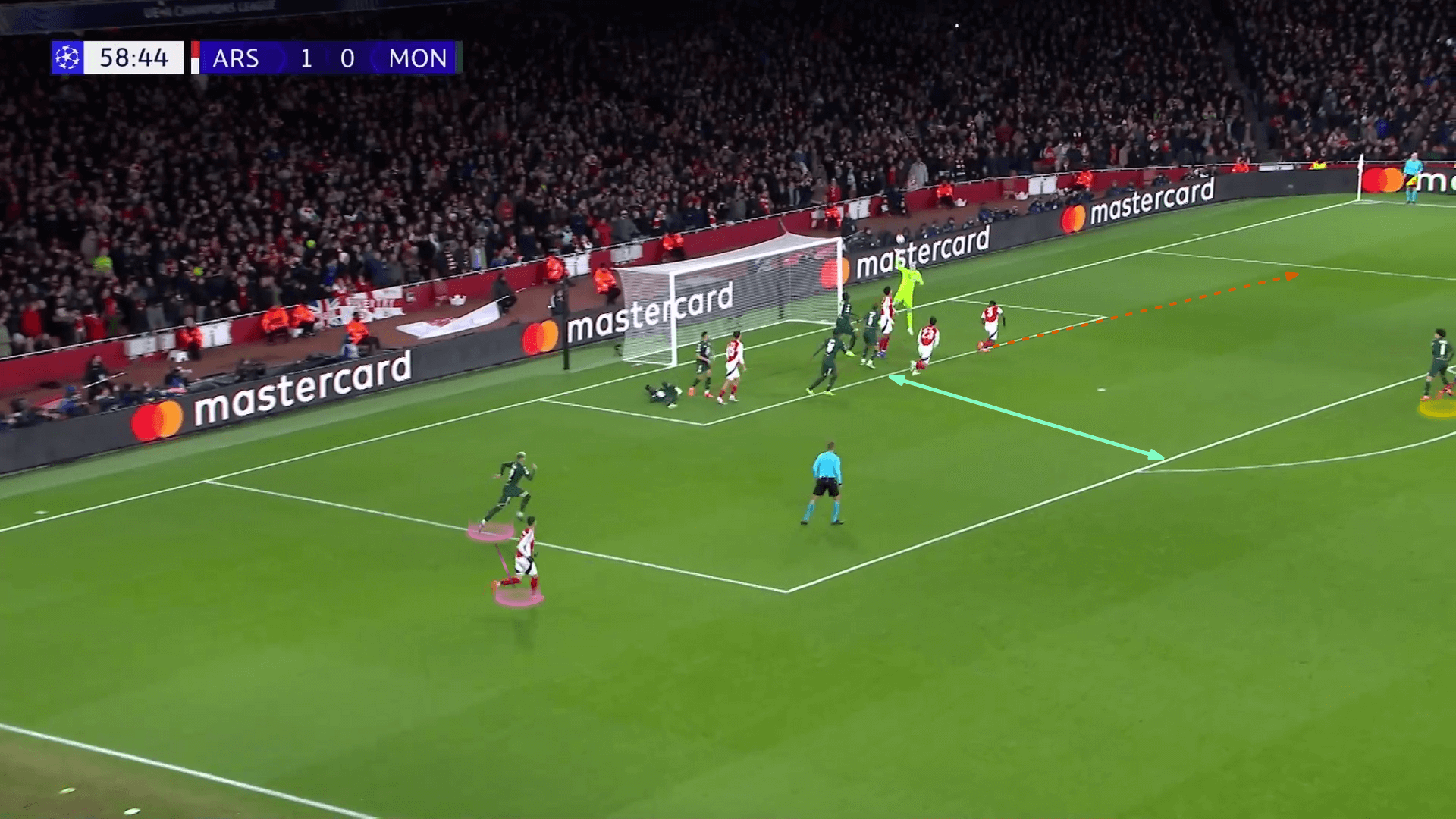
This dilemma always happens in different ways depending on the defending scheme, but in the end, the defending team doesn’t have enough players to get the second ball because you have just a player or two players outside the six-yard box.
pic.twitter.com/wRgFdVOSZ1
— Footie Clips (@FootieClips) December 24, 2024
We have discussed a situation where the cleared ball reaches the area beyond the far post.
This time, the problem occurs in the area ahead of the near post, shown below, where the taker has plenty of time to get the cleared ball.
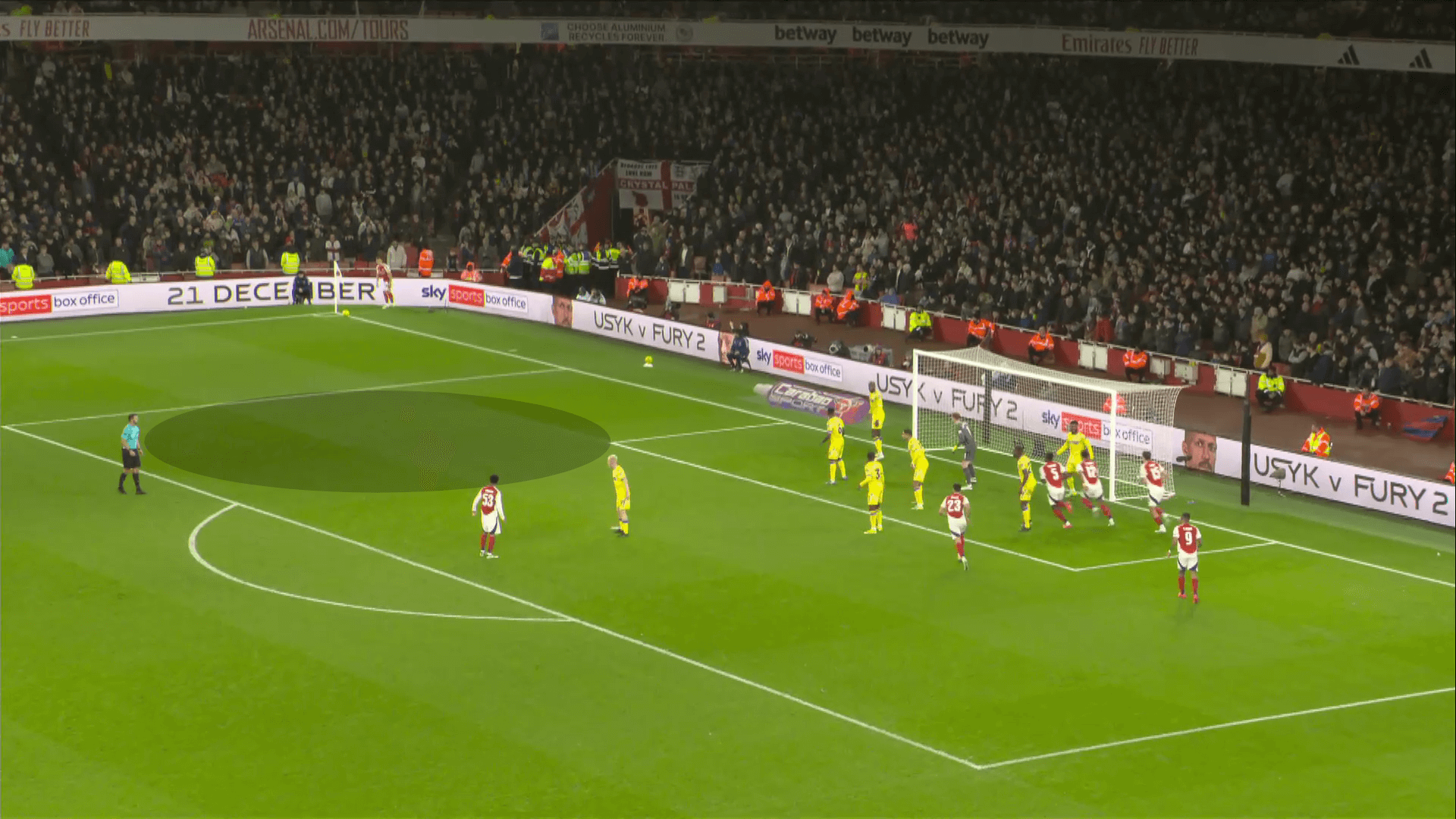
The taker (green) can reach the ball easily before the nearest opponent (the first zonal defender) while having enough space to dribble and send a dangerous cross, as shown below.
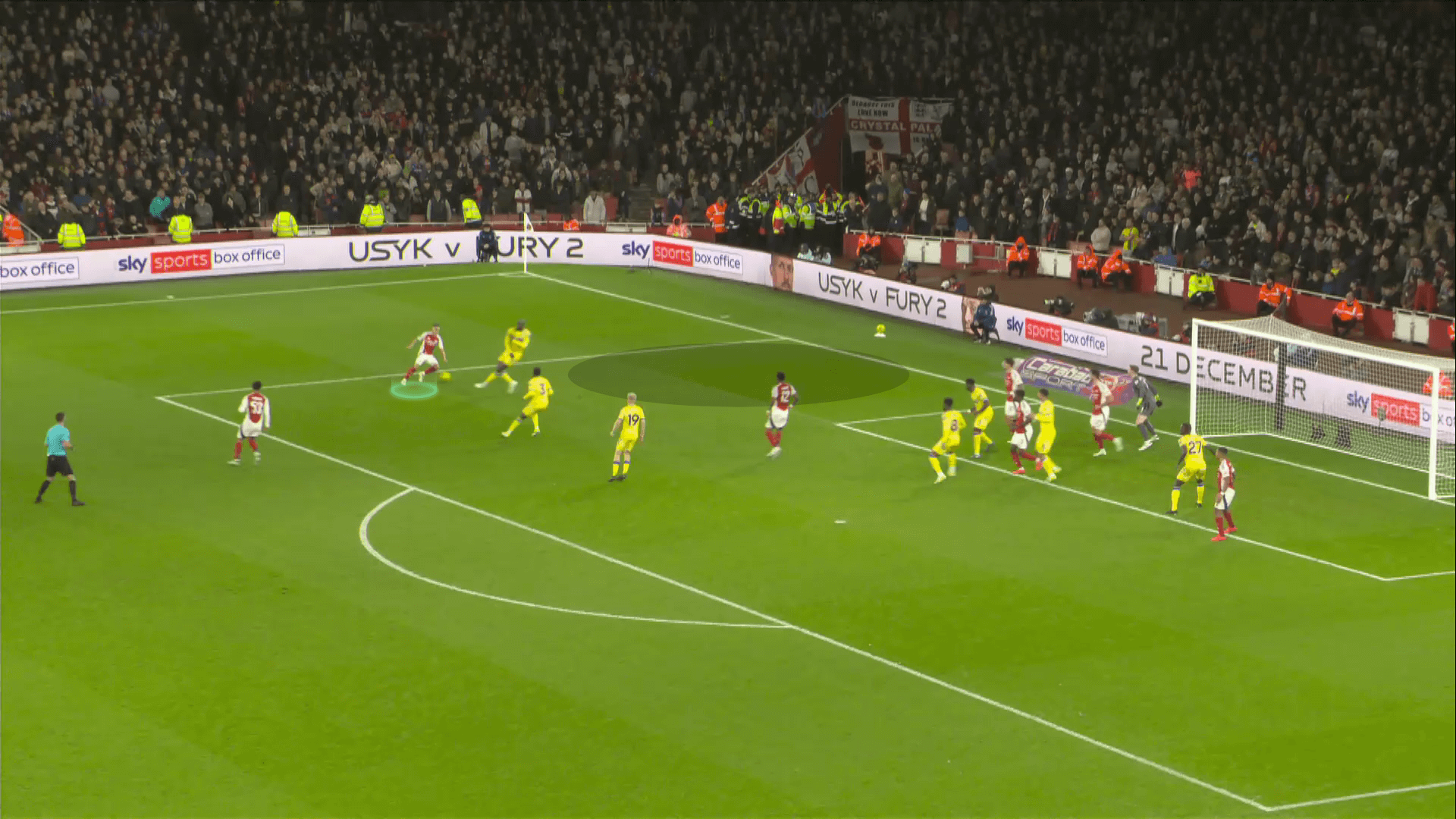
In the case below, having one player on the edge of the box makes him stand in a central position near the penalty spot, trying to fill this area and being ready to rebound, too.
pic.twitter.com/9IlHyLPMzh
— Footie Clips (@FootieClips) December 24, 2024
However, it isn’t effective in such a large area, with the rebound attacker having superiority because he faces the scene and can predict the situation.
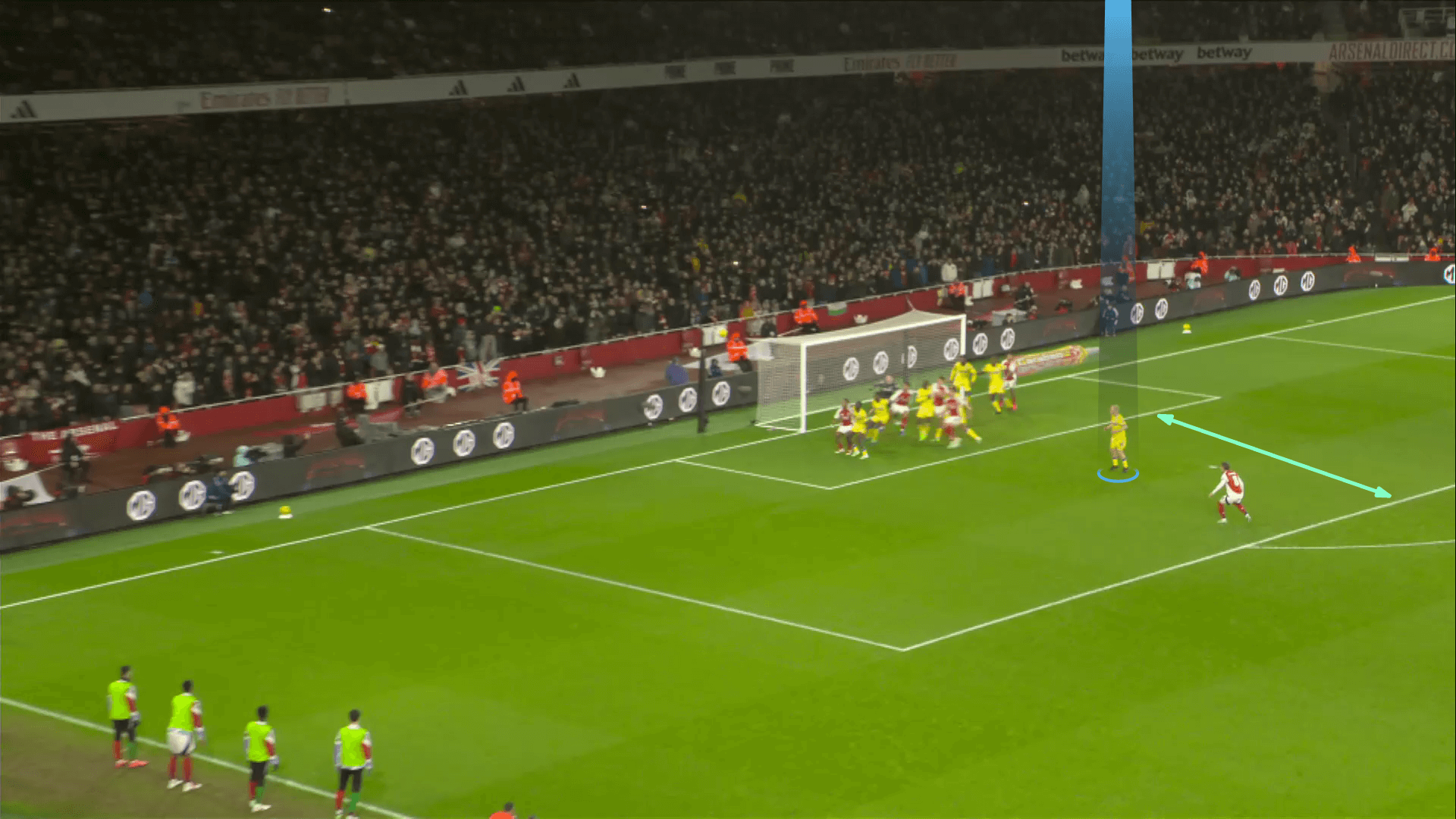
He also has to cut a long distance to get the ball in case it is cleared outside the box, as in the photo below, where the rebound attacker can get the ball to sustain pressure.
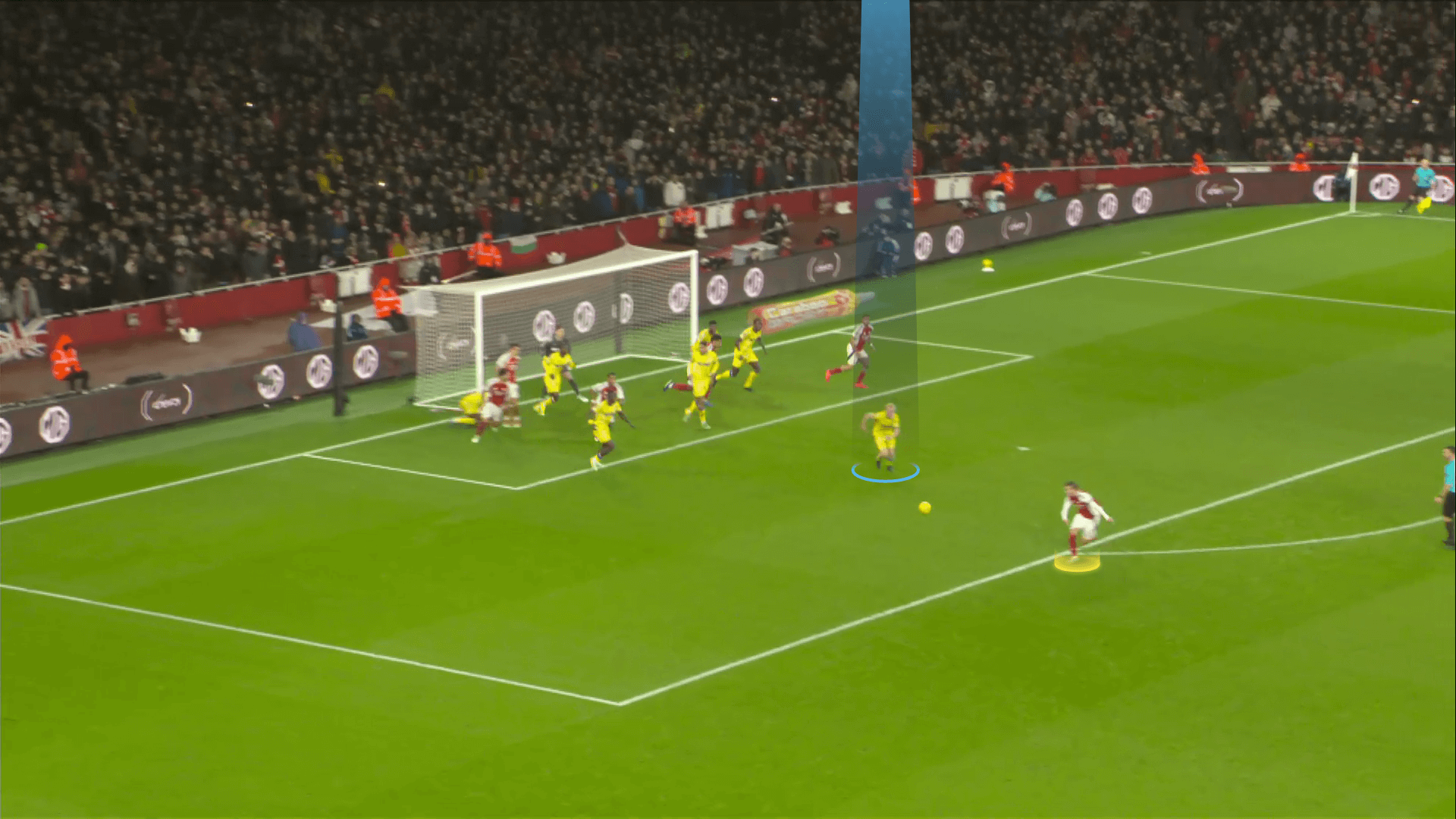
In regards to the second goal of their most recent match, the rebound defender’s middle position (blue) didn’t help, either.
pic.twitter.com/4kSl1dDkLa
— Footie Clips (@FootieClips) December 24, 2024
It doesn’t help him to get the second ball or to be committed to the edge-of-the-box attacker, as shown below.
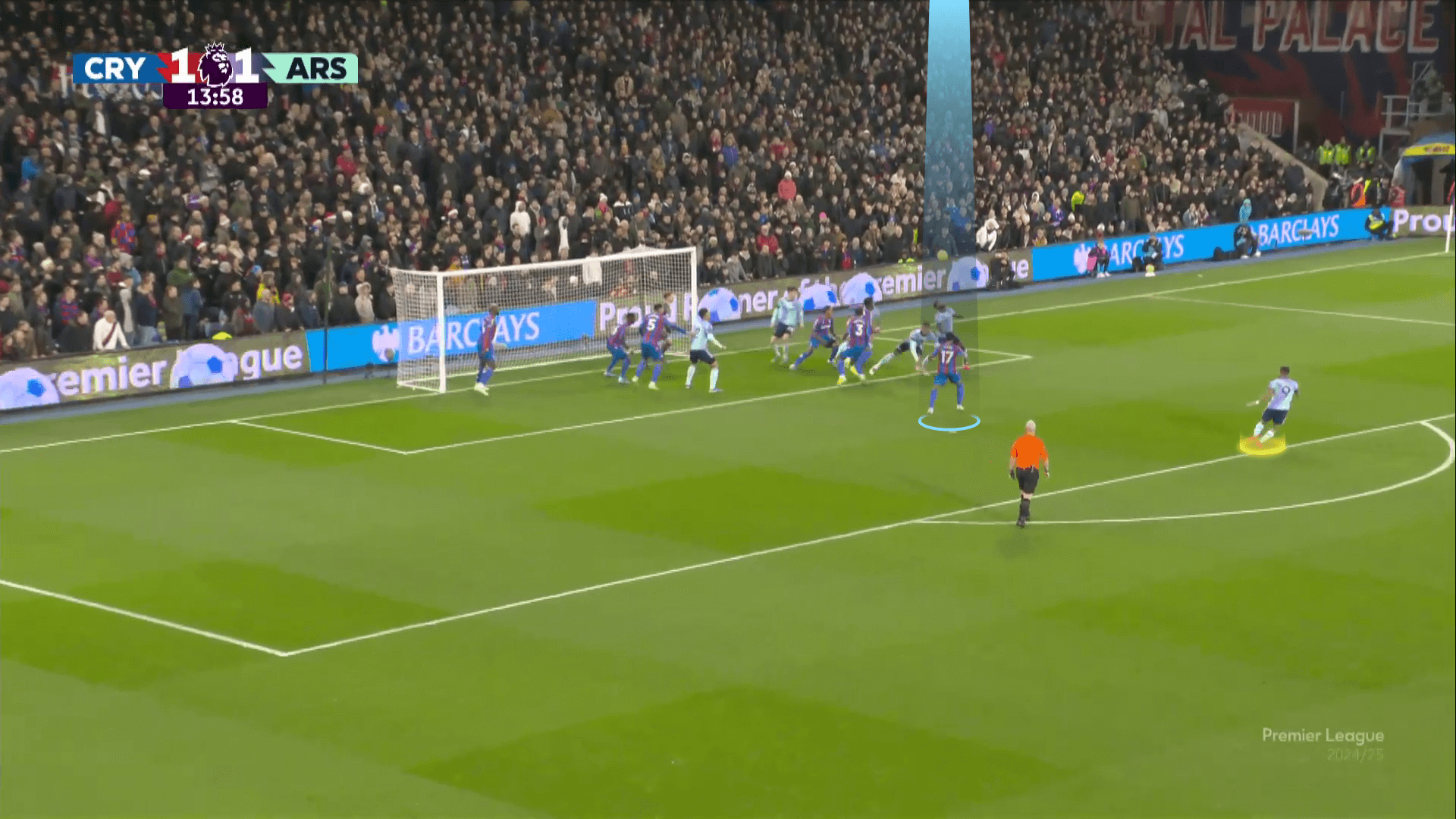
In the photo below, the rebound attacker (yellow) waits for the right moment to offer help to the ball carrier because he sees the full scene in front of him while the taker (pink) runs quickly to be an extra second-ball player.
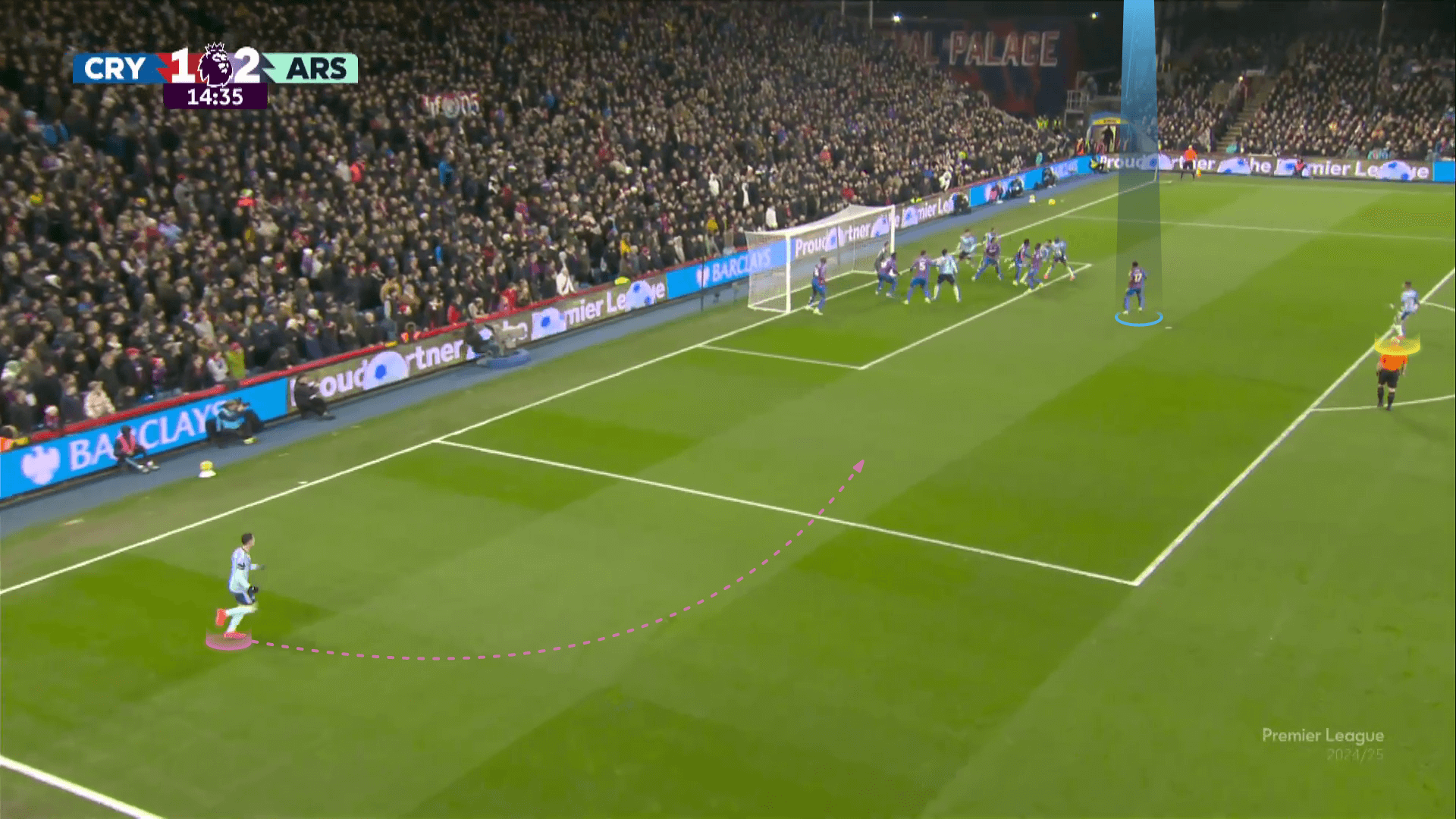
As shown below, Jesus (yellow) moves to receive a back pass and then shoots the ball into the net while the three forward players (green) try to run back, but they don’t have enough time.
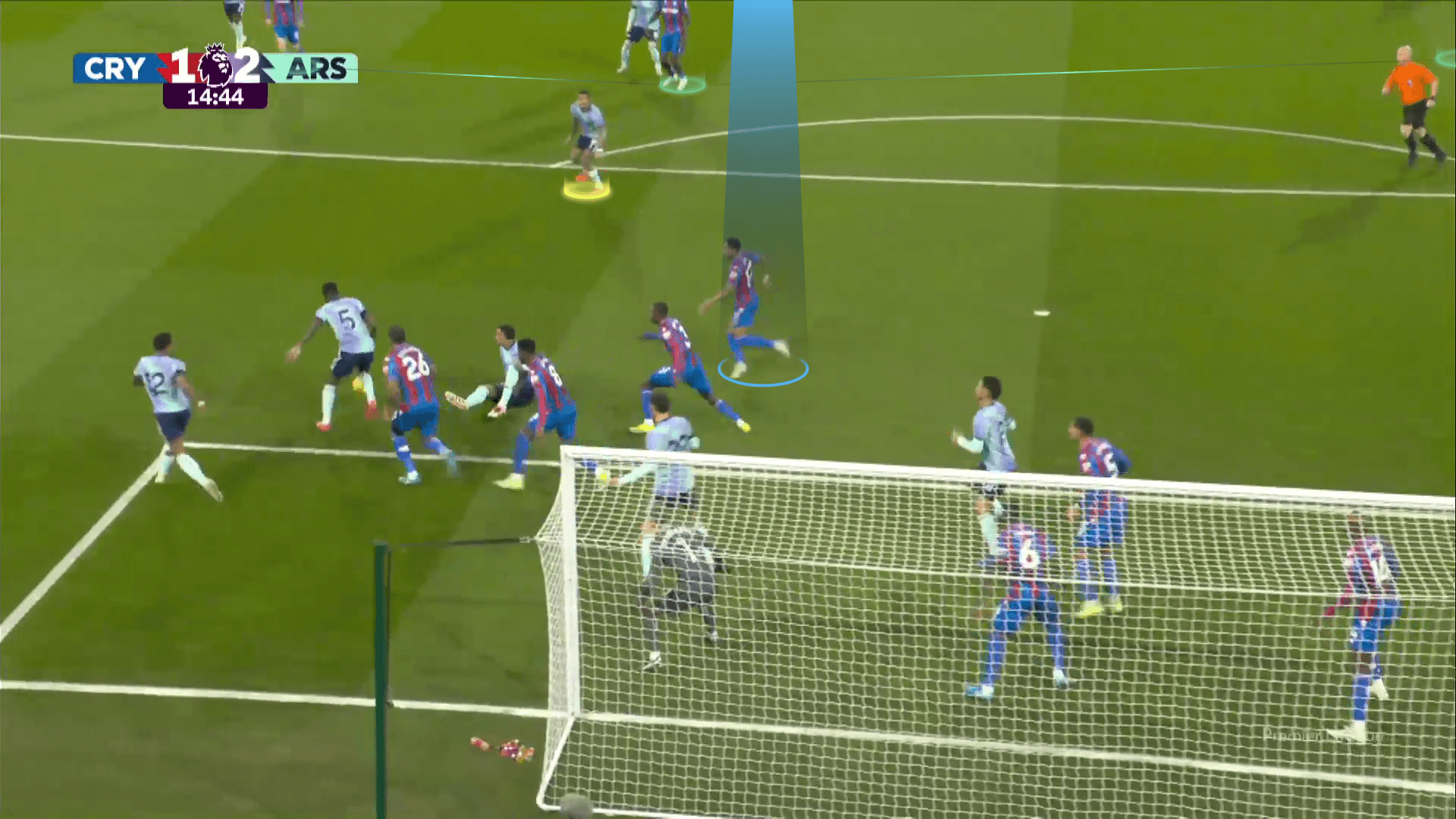
Short Corners
Let’s broaden the perspective to discuss the advantages and disadvantages of this deception in general.
Parma also follows a similar scheme, often having three or two players in the middle of the pitch during defending corners.
Fabio Pecchia’s side sometimes has difficulty defending short corners.
If they want to keep using seven players in the box, they have to defend the short corner with one player, which puts him in a two-versus-one situation, as shown in the photo below.
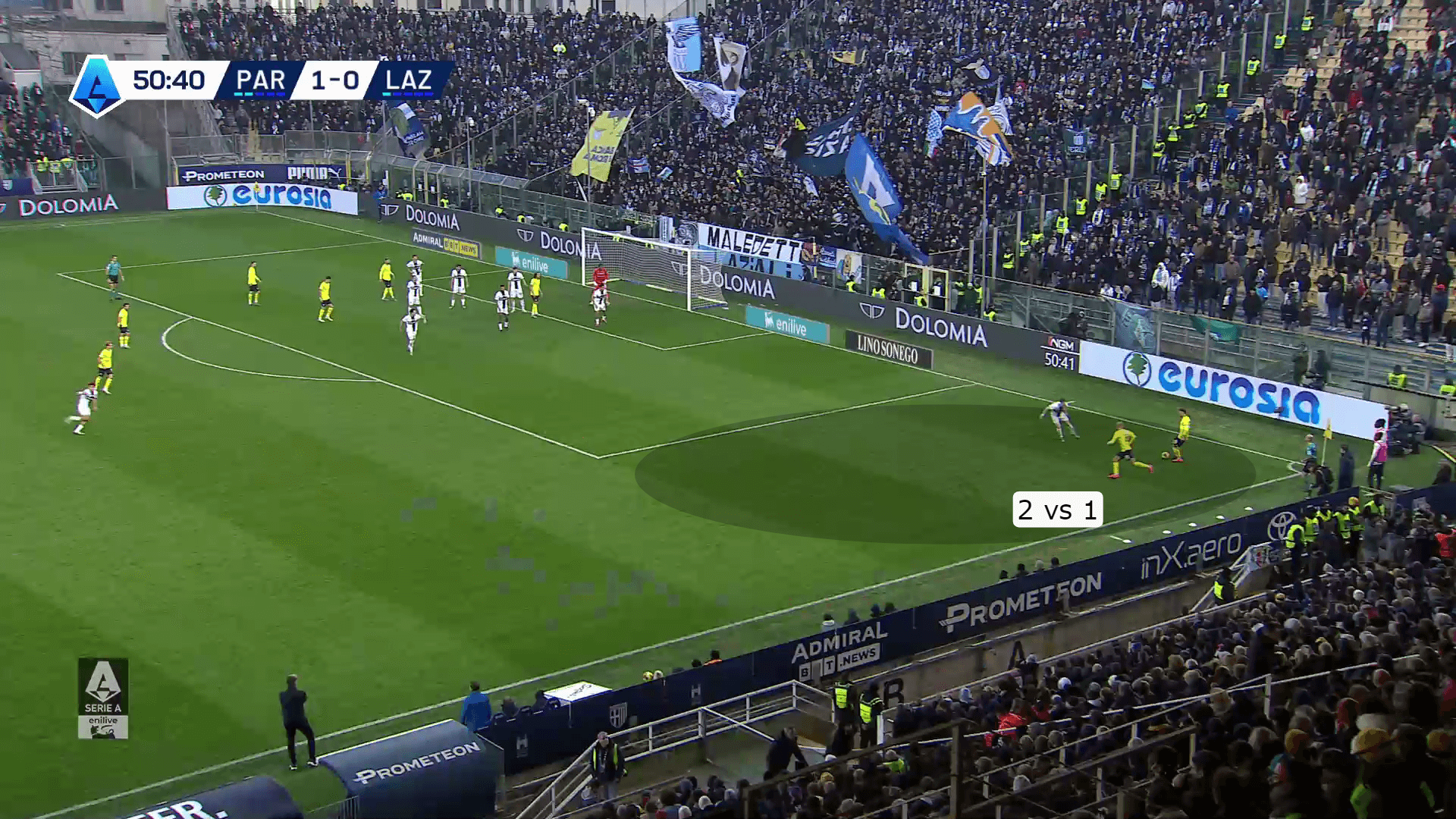
This leads to a difficult question as the attacker can shoot the ball from a dangerous area, as shown in the photo below.
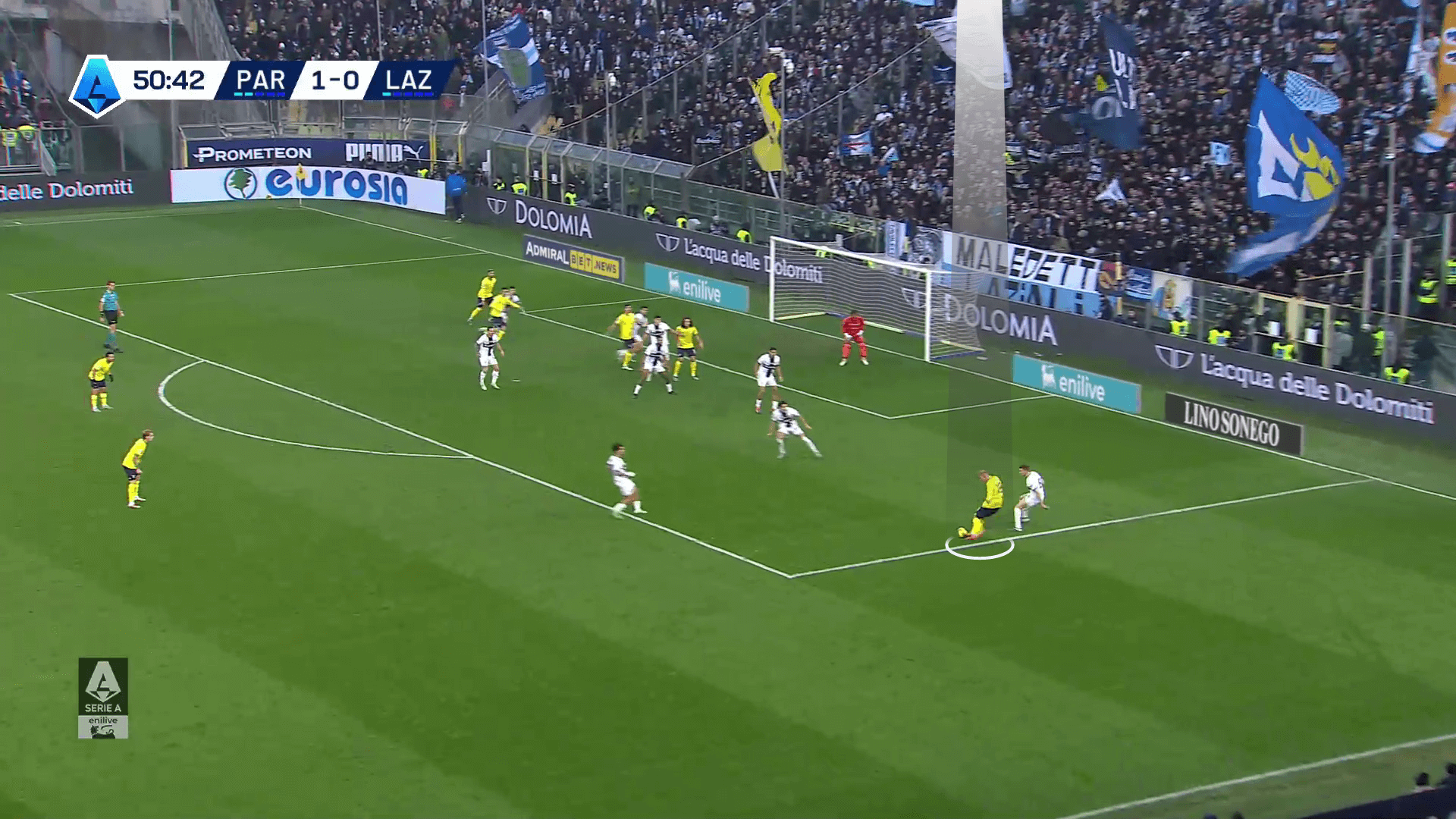
In the following match, they decided to send two players to defend the short corner, which made the box empty.
Having a player (yellow) to defend the rebound and three players in the middle of the pitch leads to just four players defending the first touch.
Having a 4v4 in the box waiting for the cross in such a big area is dangerous.
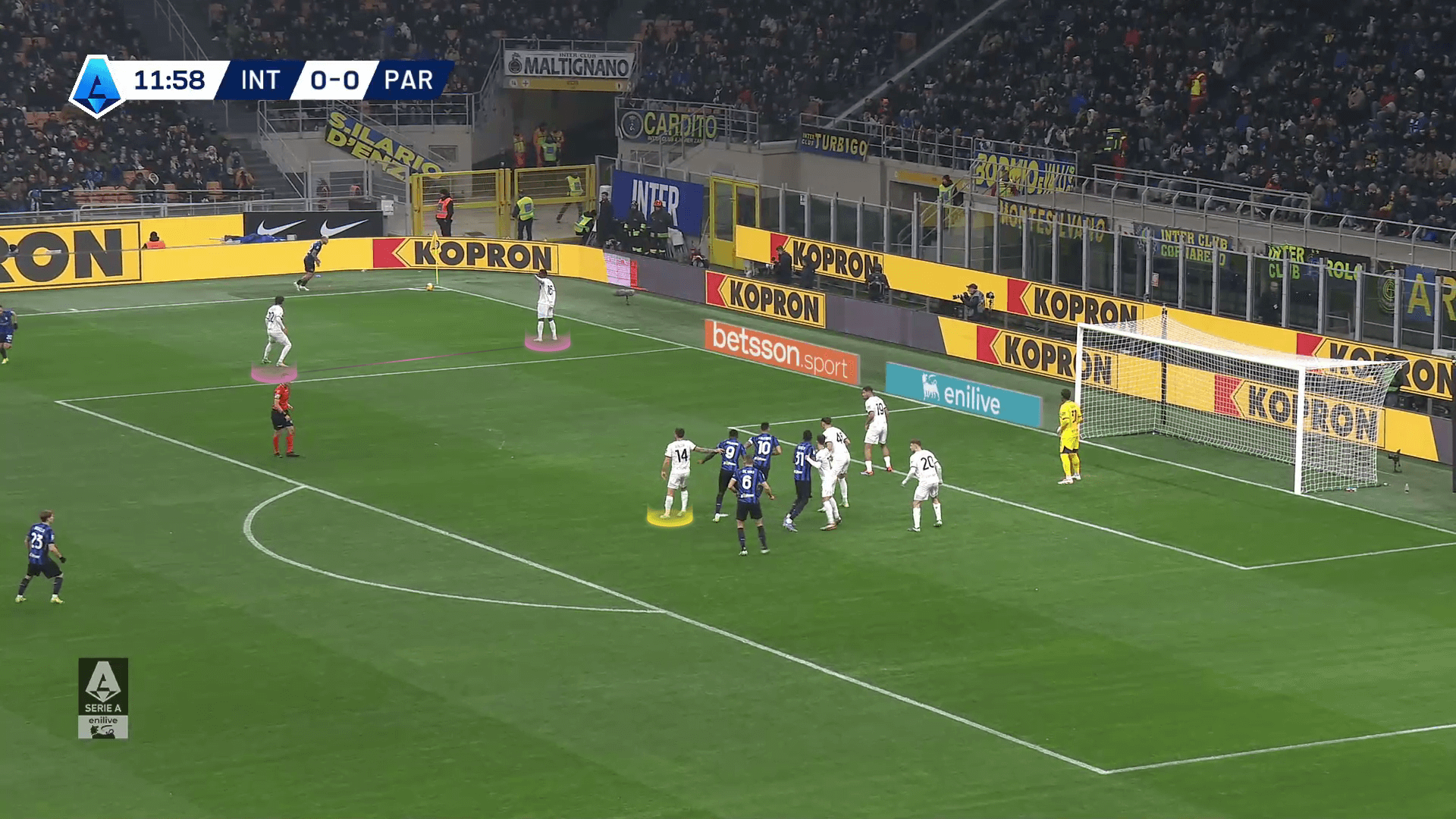
Hence, these teams live in this dilemma while trying to defend the rebound, the short corners and the box at the same time because they don’t have enough players to do so.
Probable Strengths
Of course, some coaches implement this trick for a purpose, so let’s discuss one of the advantages: the possibility of doing dangerous counterattacks, especially against non-elite teams in set-pieces.
pic.twitter.com/M92NL4regt
— Footie Clips (@FootieClips) December 24, 2024
As shown below, this trick usually frightens the opponents who try to step back.
Sometimes, the priority is being safe in the back, neglecting the importance of getting the rebound ball on the edge of the box from the beginning.
This fear can take various forms, including getting rid of the rebound player or making him take some steps back, as in the photo below.
This forces the rebound attacker far away from the defender, which is not good as a rest-defence action.
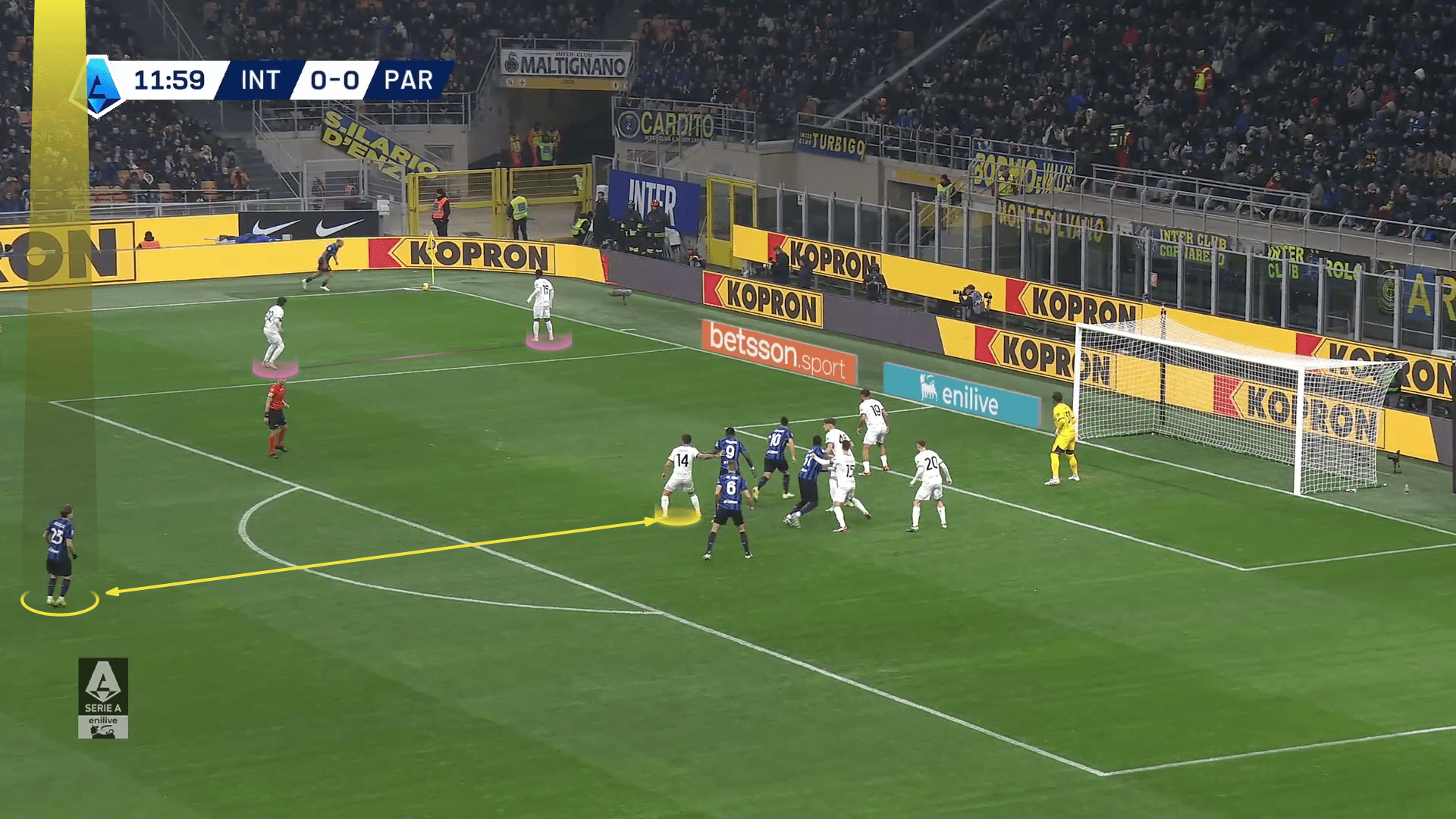
This fear causes the rebound defender to get the ball first, starting a quick transition.
The rebound attacker now tries to press him, but he is too late.
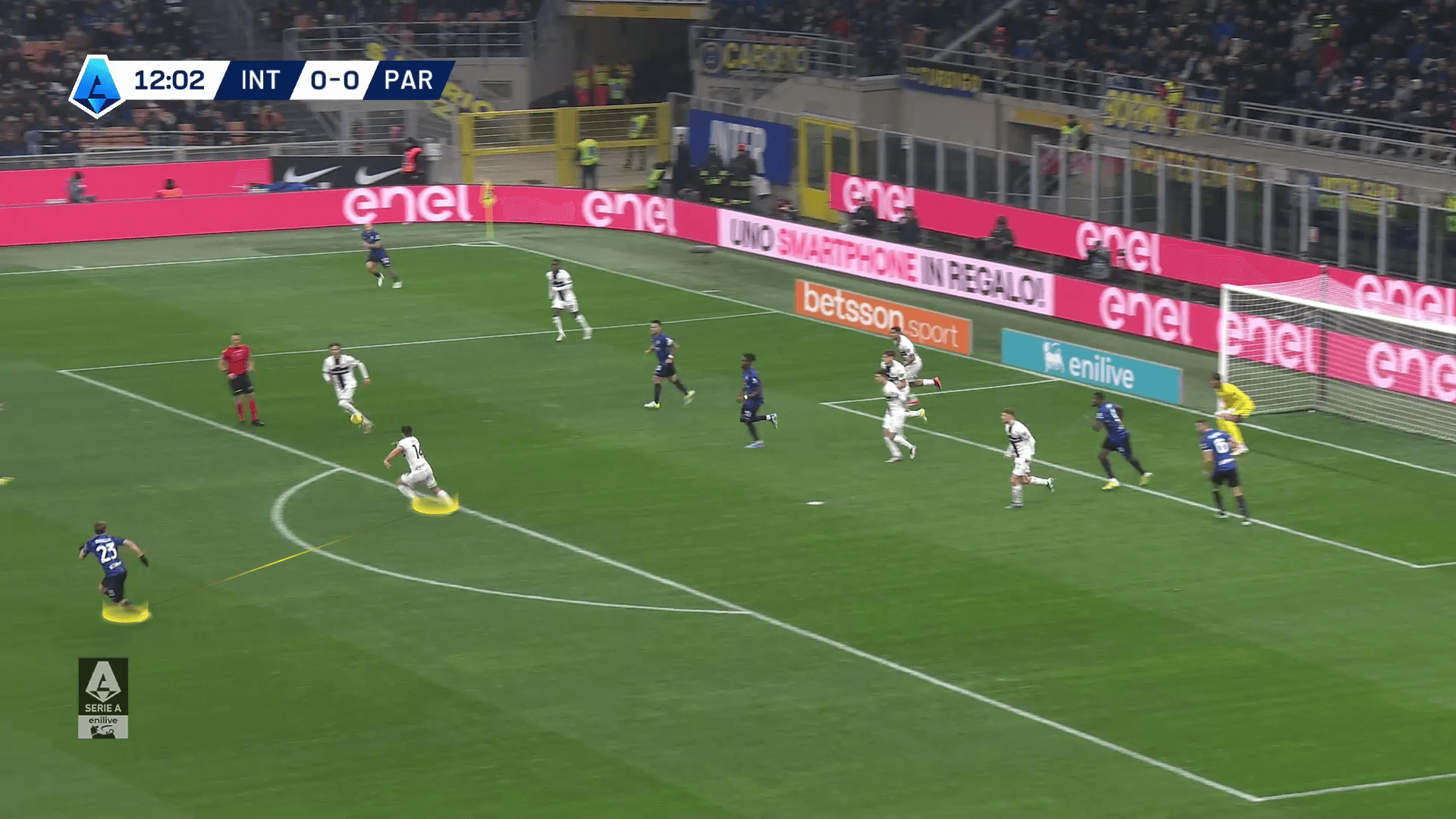
In the end, a small fear turns the situation into a dangerous counterattack, as shown in the photo below.
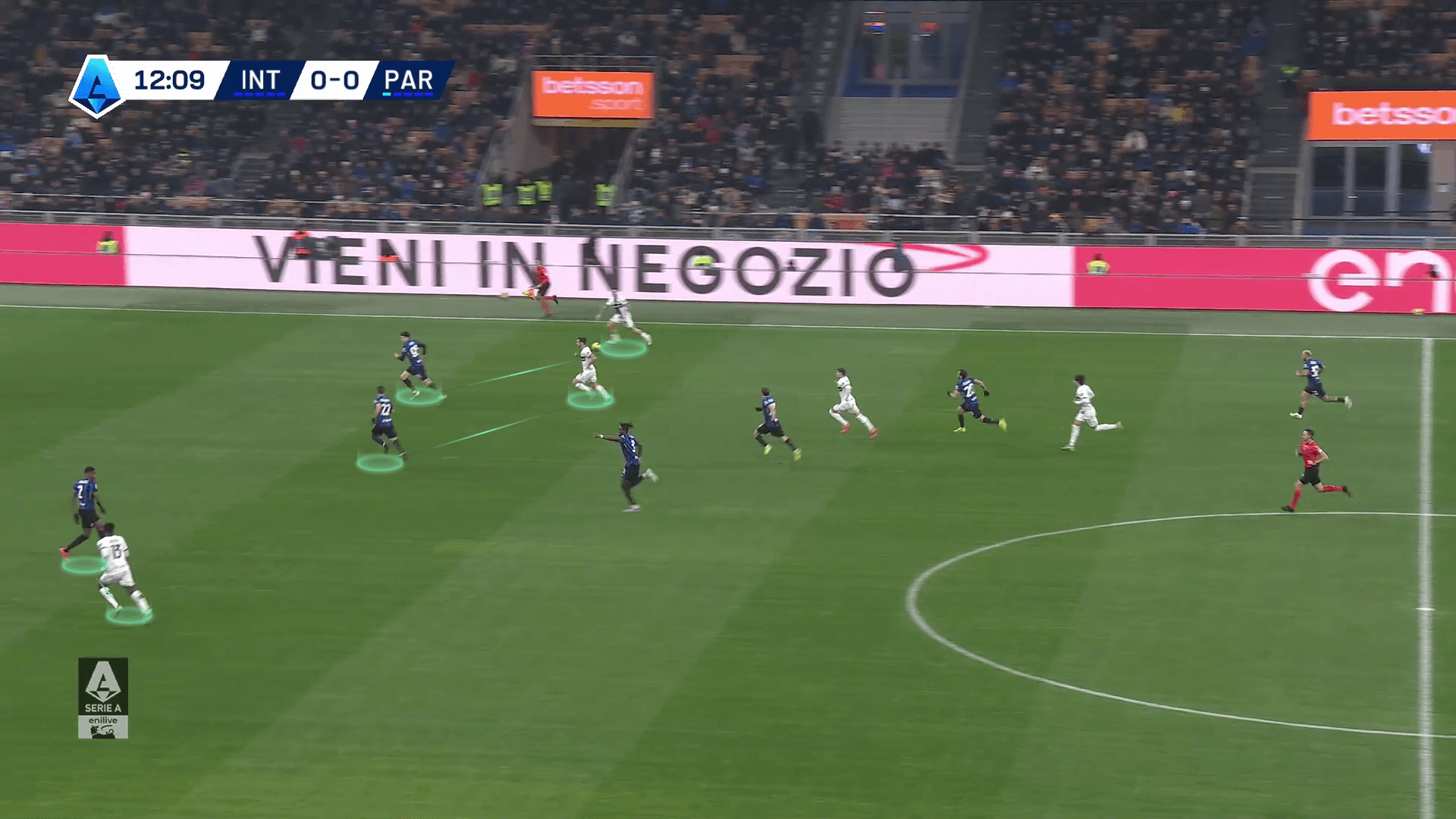
Let’s see how elite teams like Arsenal try to do their best in rest defence to prevent counterattacks from the outset.
As shown below, the rebound player starts close to his opponent for any probability after that, even pressing him quickly or going to the ball in case it lands on another point.
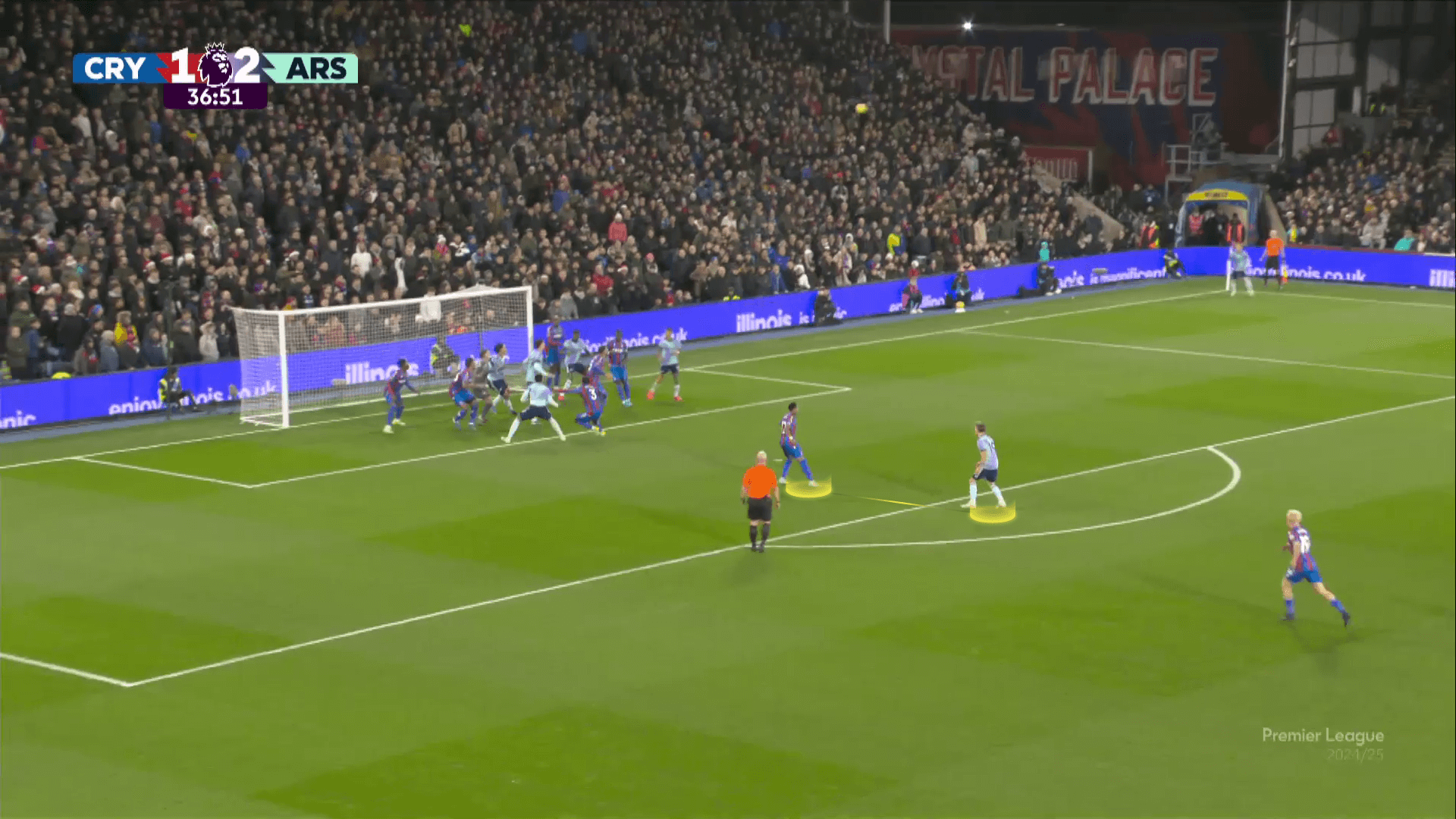
As shown below, he is sticking to him now to prevent him from turning around and starting a transition in case he gets the ball.
The taker (pink arrow) also runs inside to help get the second ball.
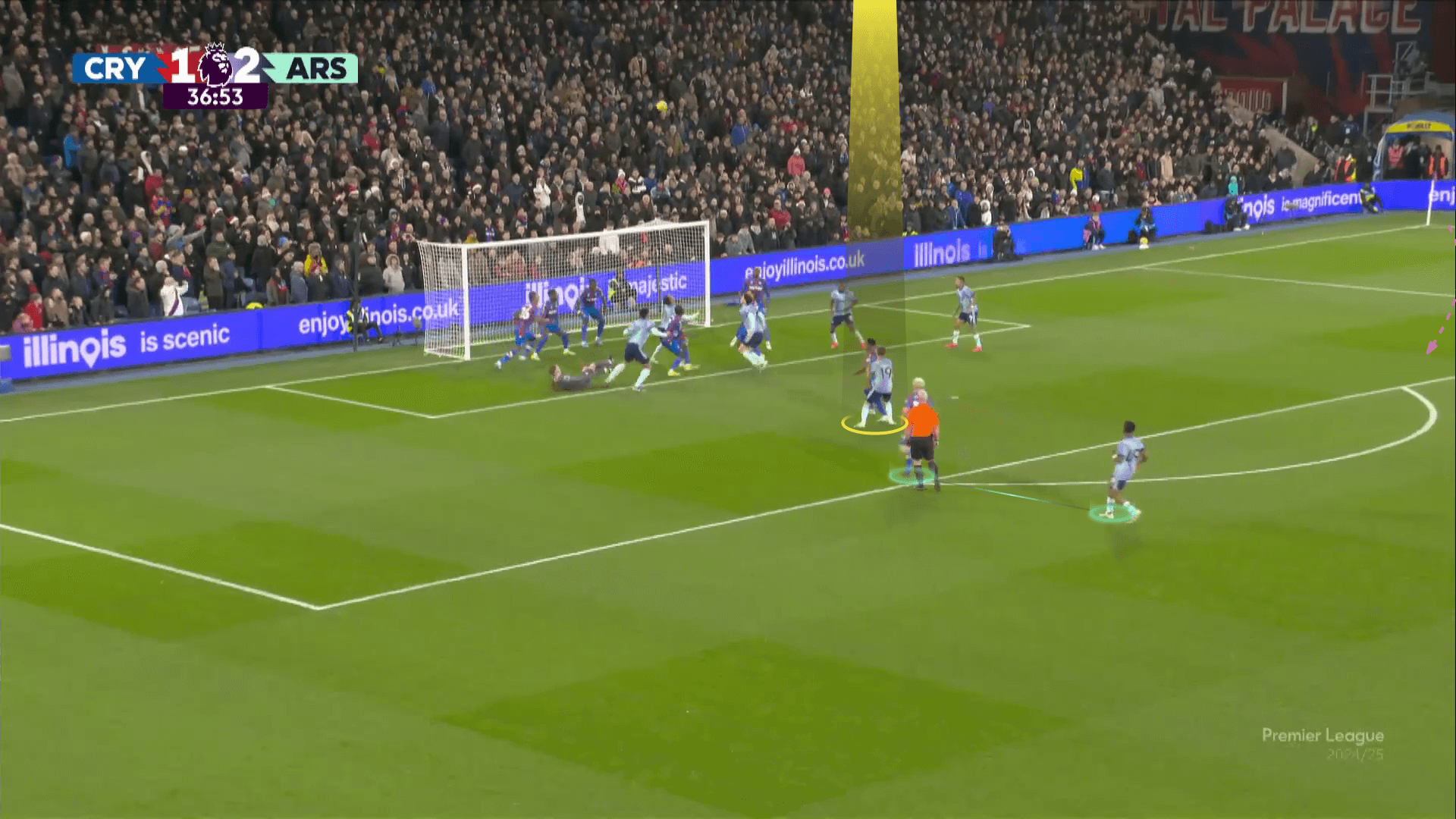
Finally, we want to highlight another opportunity to create a counterattack: the keeper’s catching possibility of the ball.
This happens for Arsenal and others.
Although Arsenal always try to hassle the goalkeeper not to get the ball, this happens in football.
If the goalkeeper catches the ball, the danger is doubled because he can skip the rebound area, send a long ball, or pass to a running teammate.
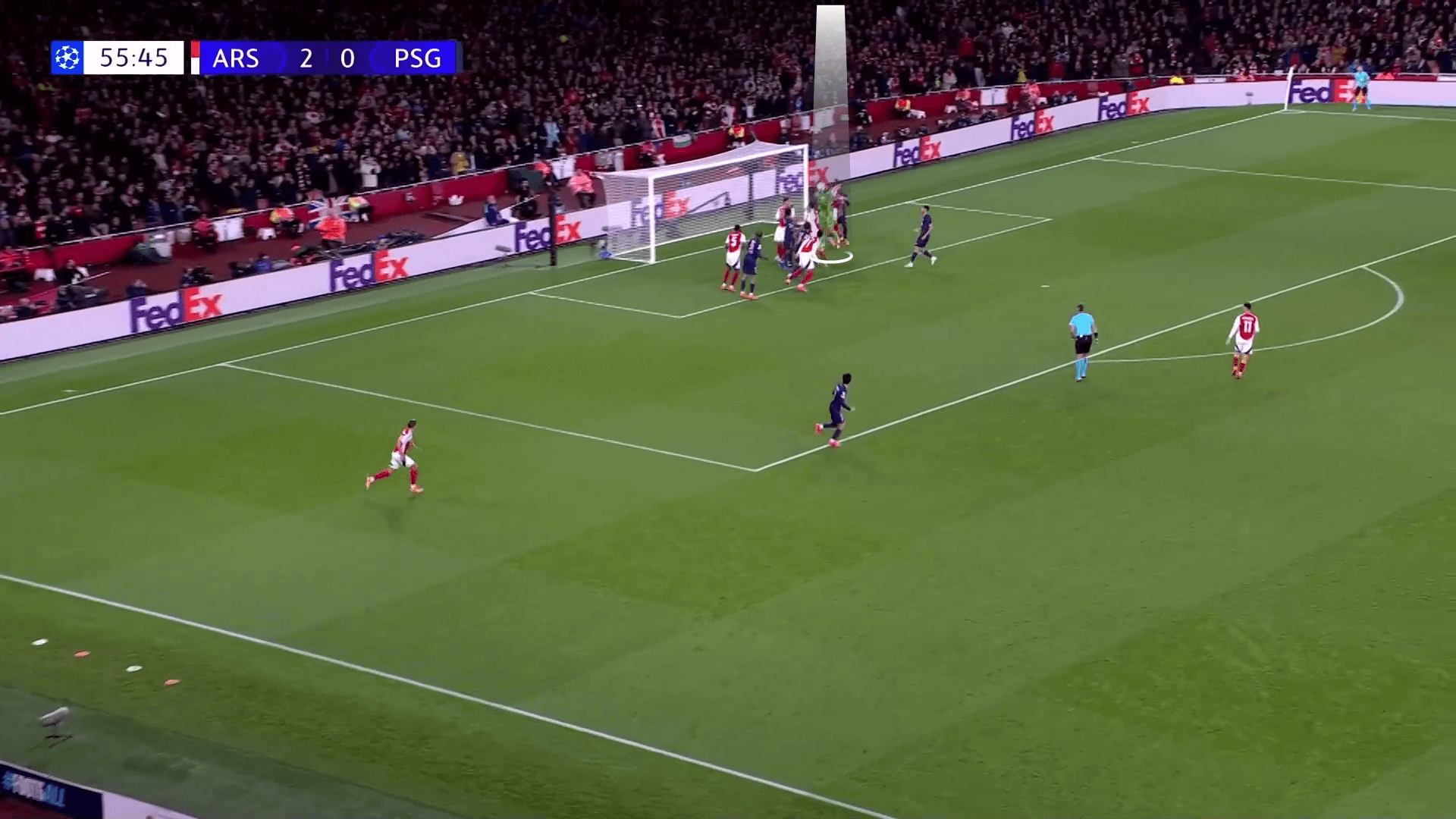
In the case below, there is an equivalent situation with three attackers against three defenders, but it can cause danger.
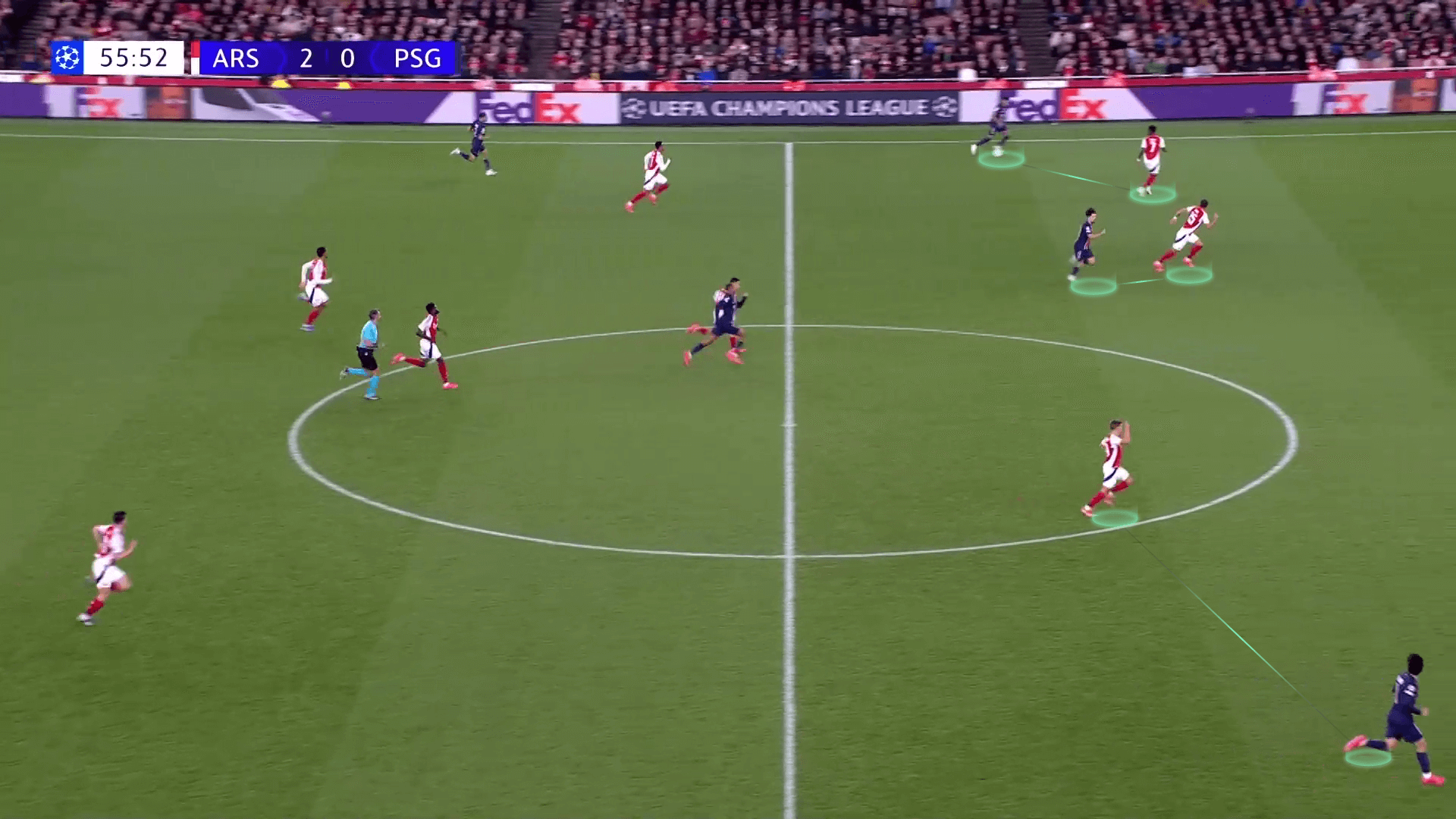
Conclusion
In this analysis, we have discussed whether it is useful to use counterattack players while defending corners against Arsenal.In this set-piece analysis, we have also explained the strengths and weaknesses of this trick, in general, giving examples from the Premier League and Serie A.
We want to confirm that football is full of probabilities.
Any chaos or individual mistake can happen, which skilled players can exploit in counterattacks.
However, we see that this isn’t an elite tactic so far.
It has more weaknesses than strengths, in case you faced an elite team in set pieces while showing how this can threaten the other teams.
We also want to highlight that nothing is guaranteed in football.
This is our opinion so far, which may change if something good is implemented later.






Comments